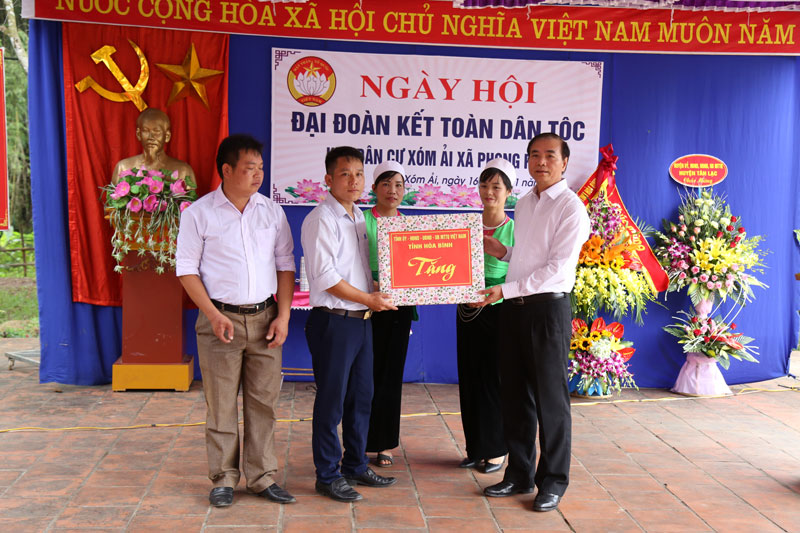
(HBO) – Member of the standing board of the Party Committee and Vice Chairman of the People’s Council of Hoa Binh province Hoang Van Tu joined a great national unity festival with people in Ai village, Phong Phu commune of Tan Lac district.
Ai village is home to 94 households
with 447 people. While performing their tasks in socio-economic development and
the campaign on building new-style rural areas and civilised urban areas in 2018,
local people have actively responded to the campaign on building new-style
rural areas over the years.
People in the village live
mainly on tourism services and agricultural production. At present, the average
income per capita in the area is estimated at 23 million VND (nearly 988 USD) per
annum. All households now have access to clean water and 98 percent of the
household have hygienic toilets.
Local residents’ cultural
and spiritual lives have been improved and all families have audio visual devices.
Attention has been paid to cultural and sport activities in the locality. This
year, 84 households, accounting for 89 percent of the total number, earned the
title "Cultural Family”.

Member of the Party
Committee’s standing board and Vice Chairman of the People’s Council of Hoa
Binh province Hoang Van Tu presents flower and gifts to local people in Ai
village, Phong Phu commune of Tan Lac district.
Speaking at the event, Tu
congratulated local people on their achievements in socio-economic development
and cultural lives. He required the Party committee, authorities and people in
Ai village to uphold the spirit of national unity, pool their ideas and
initiatives in finding new directions for developing agriculture, ecotourism,
community-based tourism in combination with building new-style rural areas.
He called on local residents
to continue engaging in the campaign on building civilised lifestyle as part of
the building of new-style rural areas, as well as protect the environment, prevent
social vice and promote healthy spiritual lives.
The locality should
mobilise financial resources for cultural activities from all economic sectors
and improving people’s cultural life. Meanwhile, local people should
effectively implement campaigns and encourage each other to join in maintaining
and bolstering cultural identity./.
With an increasingly vibrant and widespread emulation movement aimed at building cultured residential areas and cultured families, Yen Thuy District has been making steady progress toward improving both the material and spiritual well-being of its people, while fostering a civilized, prosperous, beautiful, and progressive community.
Once lacking recreational spaces and community facilities, Residential Group 2 in Quynh Lam Ward (Hoa Binh City) has recently received attention for the construction of a new, spacious, and fully equipped cultural house. The project followed the model of state support combined with public contributions in both labor and funding.
The "All people unite to build cultural life" movement, which has been effectively integrated with Kim Boi district’s socio-economic development goals, is fostering a lively spirit of emulation across local residential areas, hamlets, villages, public agencies, and enterprises. In addition, through the initiative, traditional cultural values are being preserved and promoted, while community solidarity and mutual support in poverty reduction and economic development are being strengthened.
A working delegation of the Hoa Binh provincial People’s Committee led by its Permanent Vice Chairman Nguyen Van Toan on June 11 inspected the progress of a project to build the Mo Muong Cultural Heritage Conservation Space linked to tourism services in Hop Phong commune, Cao Phong district.
Born and growing in the heroic land of Muong Dong, Dinh Thi Kieu Dung, a resident in Bo town of Kim Boi district, in her childhood was nurtured by the sweet lullabies of her grandmother and mother. These melodies deeply imprinted on her soul, becoming an inseparable part of her love for her ethnic group's culture. For over 20 years, this love for her hometown has driven Dung to research, collect, and pass down the cultural values of the Muong people to future generations.
In the final days of May, the Ethnic Art Troupe of Hoa Binh Province organized performances to serve the people in remote, mountainous, and particularly disadvantaged areas within the province. These were not just ordinary artistic shows, but they were the meaningful journeys aimed at spreading cultural values, enhancing the spiritual life of the people and contributing to the preservation of ethnic minority cultural identities.



